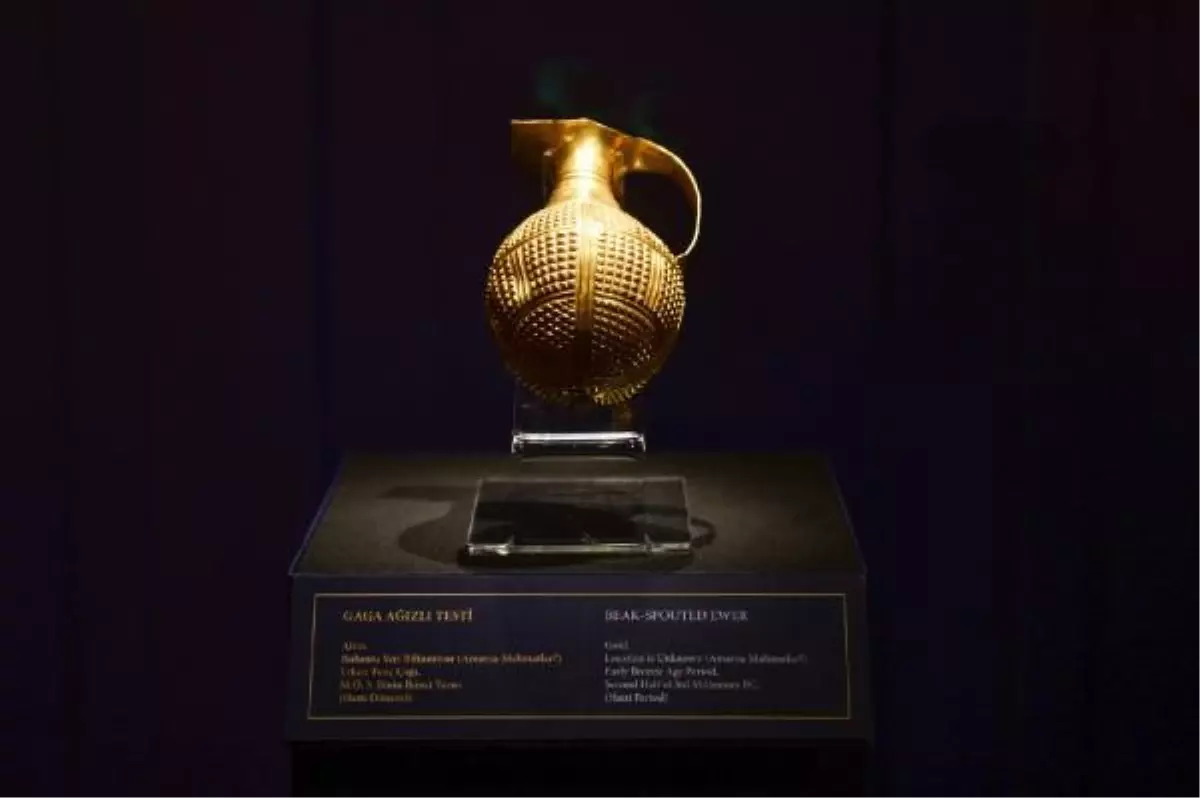4,250-yeard-old golden beak-spouted ewer smuggled from Anatolia returns to Turkey

The 4,250-year-old golden beak-spouted ewer belonging to the Hattian period, who lived in Anatolia, was identified in a museum in London and was returned to Turkey.
The 4,250-year-old golden beak-spouted ewer belonging to the Hattian period, who lived in Anatolia, was identified in a museum in London and was returned to Turkey. Stating that the artifact placed in the Museum of Anatolian Civilizations has been taken out of its context by unknown people, Minister of Culture and Tourism Mehmet Nuri Ersoy said "This cultural heritage has returned to the land to which it belongs."
Ministry of Culture and Tourism General Directorate of Cultural Heritage and Museums' department of anti-smuggling identified the 4,250-yeard-old golden beak-spouted ewer, belonging to the Hattian period who lived in Anatolia, in a museum in England. It was detected that the golden beak-spouted ewer was purchased by art collector Arthur Gilbert from Los Angeles in 1989 to complete his collection of gold and silver artifacts and was loaned to Victoria-Albert Museum in London. The Gilbert Art Foundation, founded by Arthur Gilbert, was contacted for the return of the artifact, which was found to be obtained from illegal excavations and to be smuggled out of Anatolia, to Turkey.
RETURNED TO TURKEY
Gilbert Art Foundation officials reported that they had no knowledge of the artifact's illegal past when they received the beak-spouted ewer made of gold. Turkey's ministry experts compared the artifact with similar artifacts and sent the data confirming that the artifact was dated back to the Hattian period, to the art foundation. Gilbert Art Foundation shared the results of the chemical analysis of the metal components of the artifact with the ministry. As a result of the researches, it was determined that the beak-spouted ewer was closely related to the other artifacts found in the archaeological excavations in Alacahoyuk and Mahmatlar, and similar examples were found during the archaeological excavations of the Hatti settlement in Corum and Amasya. Then, Gilbert Art Foundation returned the beak-spouted ewer, which was determined to be of Anatolian origin with style-critical review reports, and which is thought to have been used for drinking during holy ceremonies by elite rulers, to Turkey.
'TO BE EXHIBITED IN THE MUSEUM OF ANATOLIAN CIVILIZATIONS
A ceremony was held for the artifact, which was returned to Turkey as a result of the cooperation between the Gilbert Art Foundation and Turkey's Ministry of Culture and Tourism, and took its place in the Museum of Anatolian Civilizations in Ankara. Speaking at the ceremony, Minister Mehmet Nuri Ersoy said that Turkey is resolutely continuing its efforts for the return of cultural properties that have been illegally taken from their lands. Stating that they had to struggle with biased decisions, meaningless discussions, unrealistic and unscientific perspectives in the return of artifacts that were illegally taken abroad, "These and similar obstacles damage the path of constructive dialogue we want to establish in the field of culture. However, as in this case, witnessing the existence of ethical approaches is a driving force for us in tackling difficulties" said Minister Ersoy.
'FOUNDATION DECIDED TO RETURN THE ARTIFACT WITHOUT HESITATION'
Providing information on the return process of the work, Minister Ersoy said, "This artifact was purchased in 1989 by Sir Arthur Gilbert, the founder of the Gilbert Foundation. Of course, at that time he had no knowledge of its illegal past. In this process, photographs and chemical data related to the artifact were conveyed to the General Directorate of Cultural Heritage and Museums of our ministry. Experts from The Museum of Anatolian Civilizations compared the artifact with the Alacahoyuk and Mahmatlar finds and confirmed that the artifact is a cultural property of the Hatti period stylistically. Comparisons of the metal component data of the artifact were made by the experts of Ankara Restoration and Conservation Regional Laboratory affiliated with our ministry. The results were also confirmed by the mining expert Unsal Yalcın, an academician of Bochum University. After the submission of our legal basis for the protection of cultural assets and scientific data to the Board of Trustees of the Gilbert Foundation, the foundation decided to return the artifact to the land to which it belongs without hesitation. As a result of our mutual discussions, we found the Museum of Anatolian Civilizations as the right address for the exhibition and preservation of this artifact, with its magnificent Hatti collection."
'WE MUST COLLABORATE TO PREVENT ILLEGAL EXCAVATIONS'
Stating that the ceremonial nature of golden the beak-spouted ewer can be understood from the craftsmanship of the artifact, "Presumably buried as a grave gift, this artifact has been taken out of its context by unknown people. After the origin of the artifact became clear, the story of its return began; this cultural heritage has returned to the land to which it belongs. I believe that our people make the greatest contribution to the preservation of cultural assets. We must all together prevent these efforts from being damaged by some malicious people. We must collaborate to prevent illegal excavations and report any suspicious situation to our ministry or law enforcement. The return of our cultural assets abroad is important; however, the end of these processes will only come with the protection of our cultural assets in the country. Let's not forget that this protection is also a service to our country, science, and humanity" said Minister of Culture and Tourism Mehmet Nuri Ersoy.